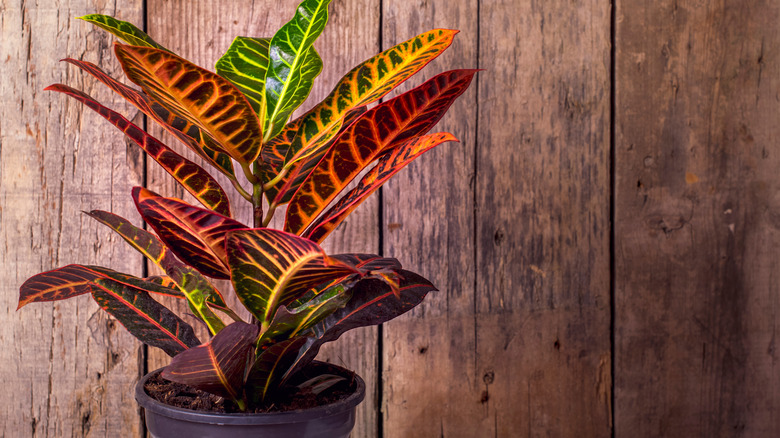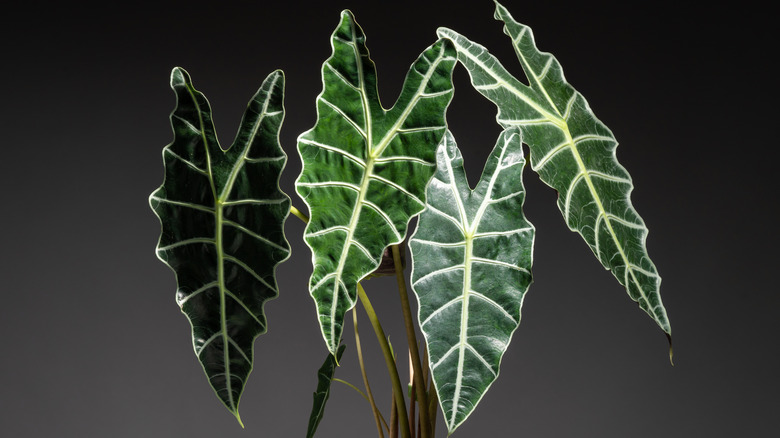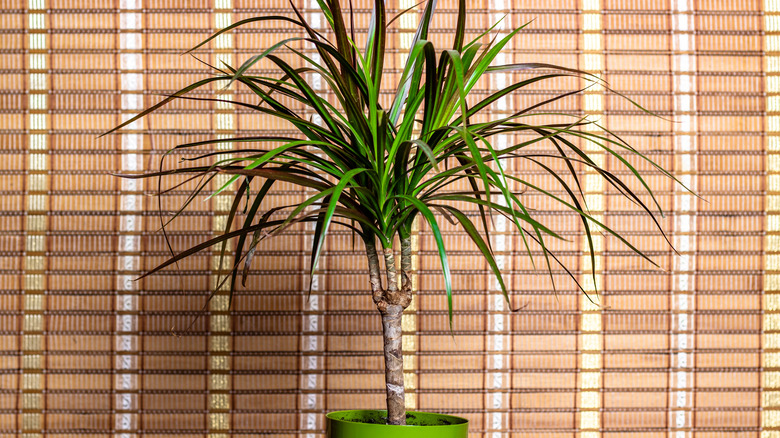15 Trendy Big-Leaf Houseplants To Add Drama To Your Home
Plants bring nature, color, and life into your house. Keeping plants in your home offers many benefits, including stress relief, uplifting your outlook, and improving the air quality in your home, per Healthline. There are hundreds of plants to bring into your home, but if you want to add a little drama, the way to do it is with plants that have large, attention-grabbing leaves.
Plants with big leaves make your living space more comfortable while also making a statement. Gary Altman, CRC, HTR, associate director of the Horticultural Therapy Program at Rutgers, told Prevention that plants "increase the relative humidity indoors, reduce noise, screen unattractive areas, and moderate room temperature by shading a bright, sunny window." So, you shouldn't be afraid to bring a showy plant into your home. If you're unsure about which plants to go with, we've compiled a list of the 15 trendiest big-leaf houseplants that will add drama to your living spaces.
1. Calathea white fusion
One plant that will bring color to your home is a calathea white fusion (Calathea lietzei). The large leaves on this plant have broad white streaks with a purple underside. They are ideal for smaller spaces, as most of them only get about 2 feet tall. They need plenty of light, but not too much. Keep in mind that the amount of light the leaves receive affects their color. Too much light will cause fading, and the colorful patterns won't develop at all if they don't get enough sunlight. To avoid root rot when watering your plant, make sure it is in a well-draining pot. It's best to keep your calathea white fusion in an area that does not experience extreme temperatures. The Spruce recommends wiping the leaves regularly, so the plant can "breathe."
Sunlight needs: filtered, bright light
Water needs: when the top inch of the soil is dry
2. Monstera deliciosa
When it comes to drama, you really can't go wrong with a monstera deliciosa. These plants are known for long, narrow holes in their huge, heart-shaped leaves. These plants do better when they are out of direct sunlight, and SFGate suggests placing them 4 to 10 feet from a window facing east, west, or south. Turn the plant regularly to keep it growing evenly. Water in the morning and remove any standing water that may be left in the drainage tray. In the winter, you can water less often, but don't let the plant reach the point of wilting. Monsteras like it humid, so if the air in your home tends to be dry, mist the leaves about once a week, and do so early in the day to allow the water to evaporate before night.
Sunlight needs: indirect light
Water needs: when the top of the soil is dry
3. Rubber Tree
The rubber tree (Ficus elastica) is a popular tropical houseplant that can grow up to 10 feet tall. Of course, you can keep them from becoming too tall by keeping them in a smaller pot. While these plants like plenty of sunlight, direct sunlight can burn the gorgeous leaves, according to Bob Vila. These plants like their soil to stay moist but not soggy. If overwatered, they can fall victim to rot root or yellow leaves. Like most other tropical plants, your rubber tree will benefit from regular mistings if the air in your home is dry. The sap from rubber trees can irritate your skin, so wash your hands after touching them. You should also place them in an area where young children and pets cannot access them easily.
Sunlight needs: bright, indirect light
Water needs: once a week in summer; two to three times a month in winter
4. Peace lily
If you want a dramatic plant that is one of the easiest to keep alive, you should consider adding a peace lily (Spathiphyllum) to your home. They produce white, sheath-like blooms all year if the conditions are right. These plants can tolerate areas with low lighting, but they do best in spaces with plenty of indirect light. Avoid areas where they will receive too much direct sunlight. They are happiest when their soil stays somewhat moist but not soggy. Peace lilies generally don't require much fertilizer, but if you choose to fertilize yours, give it only one quarter of the recommended dosage as too much will burn the roots and the tips of the leaves, per Missouri Botanical Garden. Cooler temperatures can hinder their growth, but these tough plants can survive chilly weather as long as it doesn't drop below 40 degrees.
Sunlight needs: plenty of indirect light
Water needs: water when soil is dry
5. Croton
The croton (Codiaeum variegatum) will add a pop of color to your home. Some varieties feature green leaves with yellow flecks, while others have vibrant, reddish hues. One key to keeping crotons happy is keeping them warm. If they get chilly, they may lose their leaves. Place them in a spot where they get plenty of indirect sunlight, as the amount of light they get determines how colorful the leaves become, per The Spruce. You'll probably only need to water about once a week in the summer and every two weeks in the winter — just make sure to keep the soil moist. If the leaves wilt, you may need to water more frequently. If the plants get too dry, they could drop their leaves. These plants need humidity, which contributes to their colorful foliage. If your home is dry, consider a humidifier in the room or a humidity tray under the plant.
Sunlight needs: bright, indirect light
Water needs: when the top 2 inches of the soil is dry
6. Elephant ear
If you have plenty of space and want to add some excitement to a room, look no further than an elephant ear (Alocasia). You may have seen these plants outside, but you can grow them indoors in the right conditions, preferably with lots of indirect light. You can find varieties that feature spectacular purple, black, and white leaves with variegated patterns, as well as types made specifically for growing indoors. For the best results, these plants need humidity to thrive, so you will need a humidifier in the room with them. Placing a layer of pebbles on the drainage tray under the pot will help raise the humidity as well, according to Gardening Know How. You will also need to fertilize the plant with diluted 20-10-10 food every two weeks, except during the winter months.
Sunlight needs: bright, indirect light
Water needs: keep solid moist, but not soggy
7. Hosta
If you want a showy plant that is relatively easy to grow, you can't go wrong with a hosta (Hosta spp.). The most important thing to remember with these plants is to avoid any locations where the plant will receive direct sunlight. That said, the type of hosta you have will determine how much sun it needs. Green-leafed varieties can tolerate some shade, but variegated types will need three to four hours of partial sun each day, according to The Spruce. When watering, make sure you don't get the leaves wet, and be sure to add water until you see it flowing from drainage holes in the pot. You'll need to give your plant a place to rest each winter, which means putting it in a dark area where temperatures hover around 40 degrees. You will only need to water about once a month during this time. Move the plant out of the dark in the spring. Place them in an area where your pets cannot get to them, as hostas are a popular houseplant that is toxic to animals.
Sunlight needs: indirect light
Water needs: keep soil moist
8. Dumb cane
The dark green leaves of the dumb cane (Dieffenbachia) plant look as though they have been splattered with white or cream paint. If you have trouble with plants, this one might be worth a try. They grow best in bright, indirect light but enjoy growing in the shade in winter. These tropical plants like it humid, and due to temperature changes in the winter, their growth might slow or even stop. When you water a dumb cane, make sure it gets enough so that excess drains from the bottom of the pot into a tray. SFGate advises not to overwater the plants because it can cause leaves to turn yellow. It is also recommended that you keep the plant out of drafty areas. The sap of dumb canes can burn the skin inside the mouth, so keep that in mind if you have children or pets.
Sunlight needs: indirect light
Water needs: when the top layer of soil is dry
9. Majesty palm
If you like the tropical look of palm plants, then look no further than a stunning majesty palm (Ravenea revularis). These plants can add a tropical vibe to your home with long stalks that feature broad fronds. However, they can be challenging to grow indoors. The key to making them happy is enough fertilization balanced with enough light, according to The Spruce. The best place for one is in a bright corner with plenty of water, as well as fertilization once or twice during the growing season. Majesty Palms also like their soil to be moist but not too wet. If the tips of the leaves begin to brown, try watering a bit more often. To keep them happy, they need humidity. Misting the leaves is an option, but you can also keep a tray of pebbles covered with water near the plant, per HGTV.
Sunlight needs: plenty of indirect light
Water needs: keep soil moist
10. Philodendron xanadu
There are plenty of philodendron plants to choose from, but one of the most dramatic is the philodendron xanadu, with its large, lobed leaves. These compact growers like lots of indirect light. That said, they can adapt to lower levels of light, but they may not grow as quickly as they normally would. High humidity helps these plants produce large, shiny leaves, but if your home lacks humidity, misting the leaves regularly can make up for that. Bloomscape recommends placing your philodendron xanadu away from any open doors or other areas where they will be in a draft. When watering, make sure the water drains from the bottom of the pot. Philodendrons are toxic to animals and people, so it's best to place them in areas where children and pets cannot get to them.
Sunlight needs: plenty of indirect light
Water needs: when the top layers of the soil is dry
11. Bird of paradise
A bird of paradise (Strelitzia reginae) plant will add beauty to your home with its large, oval-shaped leaves. Place your plant in a place where it will get plenty of bright, indirect light. These plants can grow 6 feet tall, so they need room. Bird of paradise plants do best when they are watered on a regular schedule, and their pots need to drain any excess water well. Keep the soil moist in the summer months, and allow it to dry out between waterings during the colder months. They tolerate humidity levels in the home fairly well, but misting the leaves occasionally helps make up for a lack of moisture in the air during winter. If you encounter any pests, use a wet cloth or warm soapy water to remove them. Pesticides or any product with alcohol will damage the sheen on the leaves, according to Apartment Therapy. One thing to keep in mind about the bird of paradise is that it won't likely bloom indoors.
Sunlight needs: plenty of indirect light
Water needs: keep soil moist in summer, allowing it to dry out during winter
12. Ruffled fan palm
The ruffled fan palm (Licuala grandis) plant might be one of the most unique plants you can have in your home. Their large, round, pleated leave make gorgeous additions to any area. If you don't have a lot of light to offer a plant, then a ruffled fan plant could be just what you need, as they don't need much light to survive (via Plant Index). In fact, too much light will damage the foliage. These plants can tolerate lower temperatures as long as they don't dip below freezing. Ruffled fan palms are slow to grow, so you might have to wait in order to see their pretty leaves, but the amount of green they will add to your space is worth it. They can grow up to 6 feet tall, so make sure they have plenty of room to spread out.
Sunlight needs: partial to complete shade
Water needs: when the soil feels dry
13. Dragon plant
A dragon tree (Dracaena marginata) has thin but dramatically long leaves and a thick trunk. Known for being easy to care for, they make excellent plants for people who have difficulty keeping plants alive. They grow slowly, so don't expect to see a lot of activity, but this hardy plant produces tiny white blooms in the springtime. To get the most out of your plant, make sure the soil drains well. Dragon trees should do well in most homes, but if the air in your house tends to be dry, occasionally misting the leaves can help keep them. Also, make sure that your plant gets some indirect light every day. Keep this unique plant in a place where animals cannot get to it because it is toxic, according to The Spruce.
Sunlight needs: indirect light
Water needs: water only when the top portion of the soil feels dry
14. Banana tree
If you like large, showy leaves, the banana tree (Musa spp.) may be the right choice for you. These plants will grow according to the size of the pot you keep them in, and if you have a small space, you can always go with a dwarf variety. Banana trees are tropical, so they like it humid with plenty of sunlight. Some varieties need as much as 12 hours of light a day. However, they may burn if they get too hot, so keep them in a bright area that doesn't get too warm, per Gardening Know How. You'll need to water your plant frequently to keep its leaves happy and hydrated. Check the soil often and don't allow it to dry out. Use a well-draining pot so the roots won't be sitting in excess water, which can lead to root rot.
Sunlight needs: bright shade
Water needs: Keep soil moist
15. Fiddle-leaf fig
With its dark green leaves shapes like fiddles, the fiddle-leaf fig will add drama to your home. However, they can be challenging to new plant owners. The key to keeping this plant happy is to place it near a window where it is safe from drafts. It needs plenty of light, but don't put it where direct sunlight will hit the leaves. HGTV recommends keeping your fiddle-leaf plant in one place and turning it periodically so it won't grow in one direction. Like so many plants in this list, these plants are tropical, so they prefer warm and humid conditions. If your home is dry, make it a point to mist your plant about once a week. You might also want to wipe the leaves with a damp cloth to keep them shiny and dust-free.
Sunlight needs: plenty of indirect light
Water needs: plenty of water every 7 to 10 days or when two inches of soil is dry















